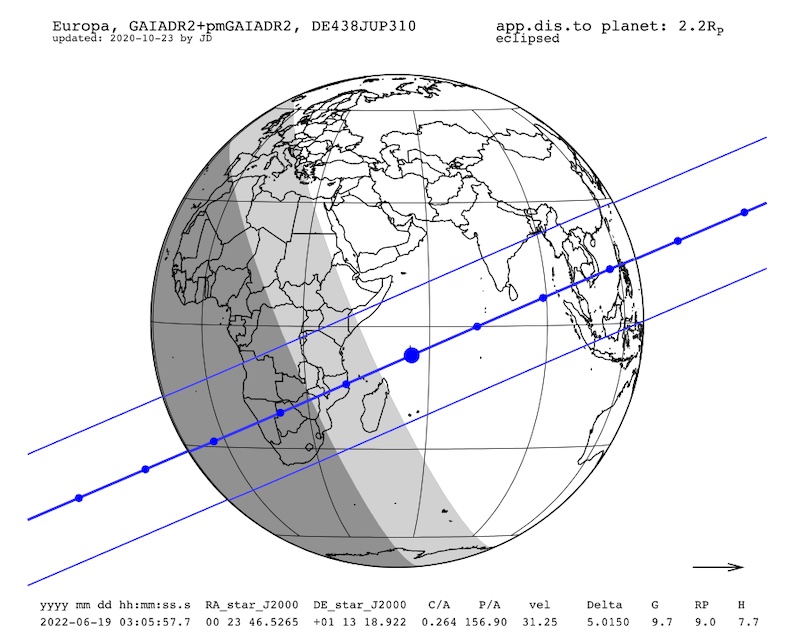
Originally published by the European Space Agency, with edits by EarthSky.
On June 19, 2022, Jupiter’s intriguing moon Europa will pass in front of a distant star, as seen from parts of Africa. The star will disappear from view, for earthly observers, for at least a minute. If you’re in Africa, and have a small telescope, this event will be easy to see!
Europa to occult a distant star
When to watch:
The occultation takes place at 03:05:57 UTC on June 19. That is when Jupiter’s moon Europa will pass in front of the star.
Where it’s visible: The occultation is visible across a narrow portion of the Earth’s surface. The center line passes through the African countries of Namibia, Botswana and Zimbabwe.
Where to look: The occulted star isn’t visible to the unaided eye. But with an apparent brightness of magnitude 9, it’s easy to find in any size of telescope. To find it on the sky, look at the coordinates RA: 00:23:46.52, Dec: +01:13:18.92 in the constellation of Pisces the Fish.
Note: Europa will be in Jupiter’s shadow during the occultation. So Europa itself won’t be visible, because it doesn’t generate its own light (it shines only by reflecting sunlight). Since Jupiter is blocking sunlight from Europa during the occultation, earthly observers will know Europa is there only when it blots out the star … making the star disappear, temporarily, from view.

Tweets from participant Frank Marchis
Success for the recording of the occultation by Europa with Josselin Desmars & Kevin Bailllie. I missed the beginning with the eVscope (one of those stupid mistakes) but I got the end. That’s why we have multiple stations. #namibia #occultation #halfhappyhalfsad #hakos pic.twitter.com/GigVG23wPK
— Franck Marchis (@AllPlanets) June 19, 2022
The occultation team at Hakos. Kevin Bailllie @Obs_Paris, Josselin Desmars @ipsa and myself (left to right) and the beautiful sky of Namibia in the background. Thanks Valery Lainey for inviting me to participate. That was a great and memorable adventure. #occultation #europa pic.twitter.com/GqSUHBniyM
— Franck Marchis (@AllPlanets) June 19, 2022
First sunset in Namibia was dazzling (thanks to the Tonga Volcano). Despite the full moon the Southern Hemisphere sky didn’t disappoint. Despite the cold we are testing our equipment to be ready for the occultation by Europa on Sunday morning. #hakos #unistellar #mission #science pic.twitter.com/GMKKZaVMpV
— Franck Marchis (@AllPlanets) June 16, 2022
Spotted at the Hakos guest farm in Namibia. Probably the best traffic sign ever. #astronomy #hakos #sky pic.twitter.com/IJfRsGBHhy
— Franck Marchis (@AllPlanets) June 18, 2022
Citizen science opportunity
By timing the June 19 occultation event – and then comparing observations from different viewing locations – astronomers will be able to refine their understanding of Europa’s orbit around Jupiter. This new knowledge will help them prepare for ESA’s JUpiter ICy moons Explorer (Juice) mission. Juice will arrive at the Jovian system in 2031. One of Juice’s objectives is investigating how starlight interacts with the tenuous envelope of gasses surrounding Europa.
Refining the orbital position of Europa, and the other moons of Jupiter, will ultimately help make ESA’s Juice mission more productive. It’ll help spacecraft operators navigate between these icy worlds more accurately. And it’ll help scientists reach conclusions from Juice mission flyby data. For example, knowing the spacecraft’s exact altitude above a moon’s surface makes calculations about the moon’s interior more precise.
Observations of the Europa occultation can be sent to europaocc2022.imcce@obspm.fr
Occultation courtesy of the mighty Gaia spacecraft
The prediction for this particular occultation uses data from ESA’s Gaia mission.
Launched in 2013, Gaia is a star-mapping mission. For some years now, it has been recording precise positions for more than a billion stars in our home galaxy, the Milky Way, over and over again. Acquiring star positions again and again lets astronomers track the motions of stars in our Milky Way galaxy. We always knew they moved! But the stars are so far away that, over the scale of a human lifespan, they appear to be fixed. Gaia lets us see the stars move, in a very precise way. We’ve learned so much from Gaia!
Earlier this week (June 13, 2022), ESA released Gaia’s much-anticipated 3rd full data seet (DR3). It contains almost 2 billion celestial objects. Read about RD3 here: starquakes, star DNA and more.
Past occultations by Galilean moons
So Gaia data were used to predict the June 19, 2022, occultation of a star by Jupiter’s moon Europa. And the data from two earlier Gaia releases resulted in predictions for several previous occultations by Jupiter’s Galilean moons, so-called because Galileo Galilei discovered them in the early 1600s. They are Io, Europa, Ganymede and Callisto.
For example, Gaia data predicted a Europa occultation on March 31, 2017. Before then, the only observed occultations by Jovian moons had been Io and Ganymede. So, thanks to Gaia’s prediction, astronomers on Earth then witnessed a Europa occultation for the first time.
Gaia data are now used to predict occultations involving all four of Jupiter’s largest moons.
Predicting occultations is one of many facets of astronomy using Gaia data. Gaia’s star data also help with the study of asteroids and moons in our solar system. Some details on Europa and the other moons of Jupiter are part of the recent June 13, 2022, Gaia data release 3.
Submit your photos here to the EarthSky Community photos
Bottom line: On June 19, 2022, Europa crosses in front of a star and causes it to disappear for about a minute. The occultation is visible from parts of Africa.











